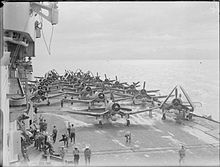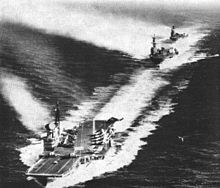HMS Victorious (R38)
[9][10] Following the sortie of the German battleship Bismarck and cruiser Prinz Eugen, Victorious, despite not being worked up and having an understrength air wing (consisting of the nine biplane Fairey Swordfish torpedo bombers of 825 Naval Air Squadron and a flight of Fairey Fulmar fighters[10][11]), was ordered to take part in the hunt for Bismarck and Prinz Eugen, sailing from Scapa Flow with the battleship King George V, the battlecruiser Repulse and 4 light cruisers on the evening of 22 May.
[15] The Swordfish, under the command of Eugene Esmonde, flew through foul weather and attacked Bismarck in the face of tremendous fire from anti-aircraft guns, scoring a hit to the 320 mm armoured belt with a torpedo.
[37] While Adolf Hitler cancelled the planned sortie on 17 November,[38] Victorious continued patrols with the Home Fleet to stop any breakout, often in very poor weather, until the end of 1941.
[39] On 19 February 1942, Victorious left Scapa Flow in company with the battleship King George V, the cruiser Berwick and seven destroyers to attack shipping in the Tromsø region, but on 21 February an RAF Coastal Command aircraft spotted the German cruisers Admiral Scheer and Prinz Eugen on passage to Norway, and the British force was diverted to try and intercept the German ships, which turned back towards Germany on being sighted.
On the night of 22/23 February Victorious launched two forces of 10 and 7 Albacores to search for and attack Scheer and Prinz Eugen but they failed to locate their targets in conditions of poor visibility.
[40][41] In March 1942, the threat posed by Tirpitz, now based in Northern Norway, resulted in the Home Fleet providing a strong covering force, including Victorious, for the concurrent Arctic convoys PQ 12 (out-bound) and QP 8 (return).
[14] Pedestal began on 10 August 1942 and involved a great array of ships in several coordinated groups; two battleships, four aircraft carriers, seven cruisers and thirty two destroyers.
Ultimately Pedestal was a success for the allies: supplies, including oil and reinforcing Supermarine Spitfires allowed Malta to hold out, albeit at the cost of the loss of nine merchant ships, one aircraft carrier, two cruisers, and a destroyer.
After crossing the Atlantic from Greenock, via the Royal Naval Dockyard on the Imperial fortress colony of Bermuda, to refit in the United States at the Norfolk Navy Yard during January, 1943.
[52] She sortied immediately for a week with Task Force 14, including Saratoga and battleships North Carolina, Massachusetts, and Indiana, sweeping against reported Japanese fleet activity, but without contact.
Rear Admiral DeWitt Ramsey, commanding the division, carried out evaluation exercises and patrol sweeps in June and determined that Victorious had superior fighter control but handled Avenger aircraft poorly because of their weight.
Victorious spent the next 28 days continuously in combat operations at sea, a record for a British carrier, steaming 12,223 miles[clarification needed] at an average speed over 18 knots (33 km/h; 21 mph) and launching 614 sorties.
Victorious left for Pearl Harbor on 31 July, leaving behind her Avengers as replacements for Saratoga, sailing in company with battleship Indiana and launching 165 anti submarine sweeps en route.
After a brief stop in San Diego, Victorious passed through the Panama Canal on 26 August and arrived at Norfolk Navy Yard 1 September, where specialized US equipment was removed.
Victorious was to participate in three further attacks on Tirpitz, in April and May (Operations Planet, Brawn, and Tiger Claw), but these were cancelled due to bad weather and anti-shipping strikes were substituted.
[14] In June 1944, Victorious, in company with HMS Indomitable, left British waters to join the Eastern Fleet at Colombo, Ceylon (now Sri Lanka), where she arrived on 5 July.
The Eastern Fleet, after a quiet period of trade protection and relative vulnerability, was now being reinforced with ships released from the Atlantic and Mediterranean, in preparation for offensive action against the Japanese.
After a short pause, on 18 September, Victorious and Indomitable attacked railway yards at Sigli in Sumatra followed by photo-reconnaissance of the Nicobar Islands (Operation Light).
[14] At the end of September, Victorious had a short interval at Bombay for repairs to her steering gear to remedy problems that had arisen during Operation Light.
The voyage was interrupted on 24 January for another series of raids, this time on Pladjoe and Manna in south west Sumatra (Operation Meridian) during which there was little opposition from Japanese aircraft.
At the end of the month, TF113 left Sydney for their forward base at Manus Island, north of New Guinea, and then continued, joining the 5th US Fleet at Ulithi on 25 March as Task Force 57 (TF57), supporting the American assault on Okinawa.
[14][57] The British carriers were attacked by kamikaze suicide aircraft and Victorious was hit on 4 and 9 May and near-missed on 1 April, but her armoured flight deck resisted the worst of the impacts.
[58] During the second half of July, aircraft from Victorious took part in a series of attacks on Japanese shipping, transport and airbases on Honshu and around the Inland Sea.
[59] In the main, however, British aircraft were excluded from the actions against the major Japanese naval bases; the Americans, for political reasons, preferred to reserve these targets for themselves.
[63] In the winter of 1946–47, the first deck trials with the Hawker Sea Fury (Mark 10) took place aboard Victorious, leading to its approval for carrier operations in early 1947.
From June that year she was modified at Portsmouth Dockyard with additional accommodation and classrooms and on 1 October 1947, joined the Home Fleet Training Squadron, replacing the battleship Nelson.
[67] Her hull was widened, deepened, and lengthened; her machinery was replaced with Foster-Wheeler boilers; her hangar height was increased; new armament of 3 inch (76 mm) guns was installed; a fully angled flight deck (of 8 degrees) and steam catapults were added.
It sank very slowly, but the plane-guard helicopter crew couldn't release the pilot, and it was seen that Cdr Russell had opened his canopy and then closed it again, possibly an effect of gravity on the heavy frame.
[71] In April 1966 she departed again to serve with the Far East Fleet for a year, during which she proved capable of landing and then launching a US Navy Phantom F-4 from USS Ranger,[72] returning to the UK for a refit period from June 1967.
[73] On 11 November 1967, after the completion of the 1967 refit and shortly before the start of what was intended as the ship's final commission, there was a relatively small fire, which was rapidly extinguished, in the chief petty officers' mess (resulting in one death and two hospitalisations[74]).









